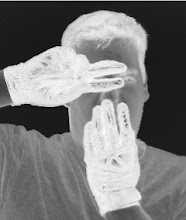
I visited Cockatoo Island on the weekend to view the artworks of the Biennale. I plan to write about it soon, but before I do I think it is important to provide some information about this place*.
Before European colonisation, the island was known as Wa-rea-mah a title given to it by the Aboriginal people. Like much of the SinCity harbour area they lived a fairly peaceful existence and there is evidence to suggest they fished from this island. In 1839, and with European colonisation in full swing, it was decided to establish a convict settlement on the island. There are reports that a culture of extreme brutality existed, as the convicts were originally from the Norfolk island settlement and were regarded as the most vile and despicable rougues of the British Empire. With Cockatoo island being remote and difficult to access, all manner of mistreatments could be exercised without the general public being aware. Hard labour was the order of the day and there are many examples of this dotted about the island. Many convicts were worked to death and their bodies are rumoured to still be on the island, albeit never found.
Between 1870-1880, prisoners were relocated to Darlinghurst Gaol and Cockatoo Islands convict history was at an end, or so it seemed. Records have been questioned as the islands commander at the time was considered a notoriously corrupt villain. Apparently the number of convicts transferred did not tally with expectations, even though the records presented by the commander indicated all had. An investigation was initiated however before it could be completed the commander was killed when a drunk cut his throat in a bar-room brawl in Sydney's Rocks area, and the senior record keeper for the island was found drowned in the Fitzroy dock on the island. All remaining records mysteriously disappeared around this time.
With the removal of the convicts, the island became an industrial school and reformatory for girls and a ship the "Vernon" was anchored nearby to train orphaned boys. Again there are rumours of mistreatments and poor record keeping. It has not been possible to determine how many young boys and girls were sent to this place particularly as in 1888, due to overcrowded prisons, the worst offenders were returned to the island. It was in 1908 that Cockatoo Island would end its "official" role as a host for prisoners and young girls and boys without a home.
Australia became a federation in 1901, and in 1913 Cockatoo Island was to become the Commonwealth Naval Dockyard. From the outset security was high, and all workers were sworn to secrecy as to the activities on the island. Efforts to properly resolve the questions of the islands inhabitants before this time were blocked in the interests of national security. The island became a centre for heavy industry in shipbuilding and repair, with thousands of workers. In 1992 the dockyard closed and it was determined that the heavy industry had created severe contamination issues on the island and so was quarantined from any visits from the general public for the next nine years.
In 1996, a young Sydney University student, Melissa Cambridge, was sitting in the hospital room of her Grandfather, Arthur, who was dying. In a seemingly delirious moment after being administered pain relief he began to speak of some of the "people of the island", how he was warned to not converse with them, and how they were kept in the tunnels that had been built through the island. (He also spoke of a special "cargo" that was onboard a US warship docked for repairs on the island during the latter years of WWII, but his speech was at a point of nonsensical). Melissa made enquiries with her parents, but they were unaware of what Arthur was talking about and said he hardly ever discussed his time on the island. Her enquiries with the Navy and government resulted in standard form letters that gave only a brief detail of the islands history. Her requests to visit the island were rejected due to the risk from the contamination.
On the evening of 3rd April, 1997, according to police reports, Melissa Cambridge and three of her friends decided to attempt to visit the island illegally. A witness saw them leave in a small boat from Drummoyne just after dark, and this would be the last time they were ever seen again. On that night a man fishing from his dinghy on the harbour reported to police the sound of rivetting and the sight of smoke coming from the large chimney on the island. The police were unable to investigate due to the contamination quarantine, however they passed the report on to the defence department who investigated and advised nothing unusual on the island.
In 2001 the island, reportedly rehabilitated from the contamination, was handed over to the Sydney Harbour Federation Trust. In 2007 the island was opened to the public, including campers who can spend the night on the island. There have been many reports of unusual happenings by overnight visitors to the island.
*Note: Much of the information provided in this post can not be substantiated.

Cockatoo Island is a beautiful place with a creepy past. The Aussie author Catherine Cole has a mystery thriller called 'Dry Dock' set on and around the island.
ReplyDeleteMitzi.. The creepy past seems to have carried over into a creepy present. A perfect setting for a horror movie, or a BDSM party.
ReplyDeleteHow sad for Melissa's family
ReplyDeleteFear not, nursemyra, I doubt the story about Melissa is even true. The island has it's ghosts, but most of them are the product of fertile imaginations.
ReplyDelete